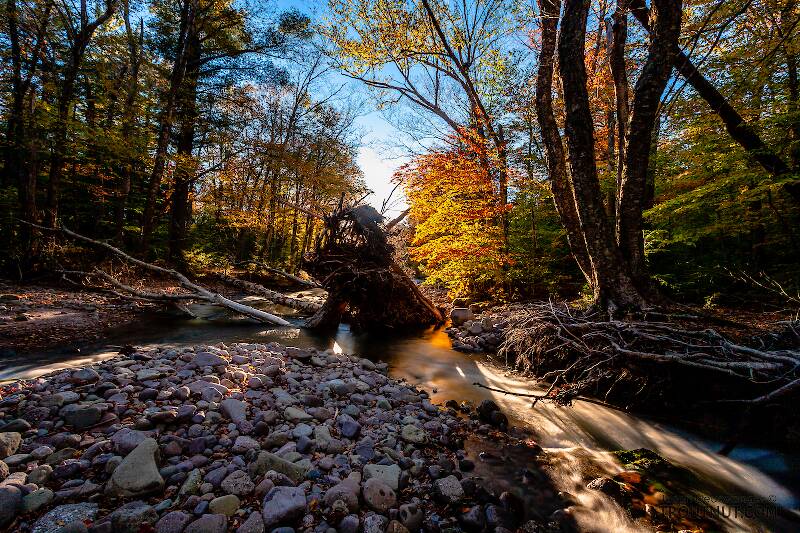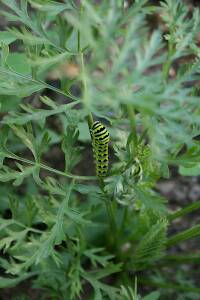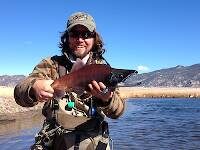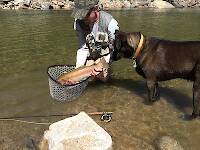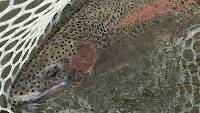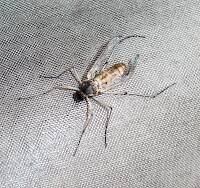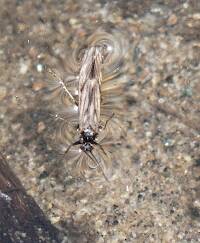
Hex Mayflies
Hexagenia limbata
The famous nocturnal Hex hatch of the Midwest (and a few other lucky locations) stirs to the surface mythically large brown trout that only touch streamers for the rest of the year.
Featured on the forum

This one pretty clearly keys to Kogotus, but it also looks fairly different from specimens I caught in the same creek about a month later in the year. With only one species of the genus known in Washington, I'm not sure about the answer to this ID.

Troutnut is a project started in 2003 by salmonid ecologist Jason "Troutnut" Neuswanger to help anglers and
fly tyers unabashedly embrace the entomological side of the sport. Learn more about Troutnut or
support the project for an enhanced experience here.
TSR on Apr 30, 2012April 30th, 2012, 2:36 pm EDT
After a year-long hiathus I resumed searching for wild rainbow trout in the mountains in Western Mexico (Sierra Madre Occidental)... Luckily I caught three of them while nymph flyfishing.
One of them had this caterpillar-like bug in its mouth. Can Anyone help with its identification?
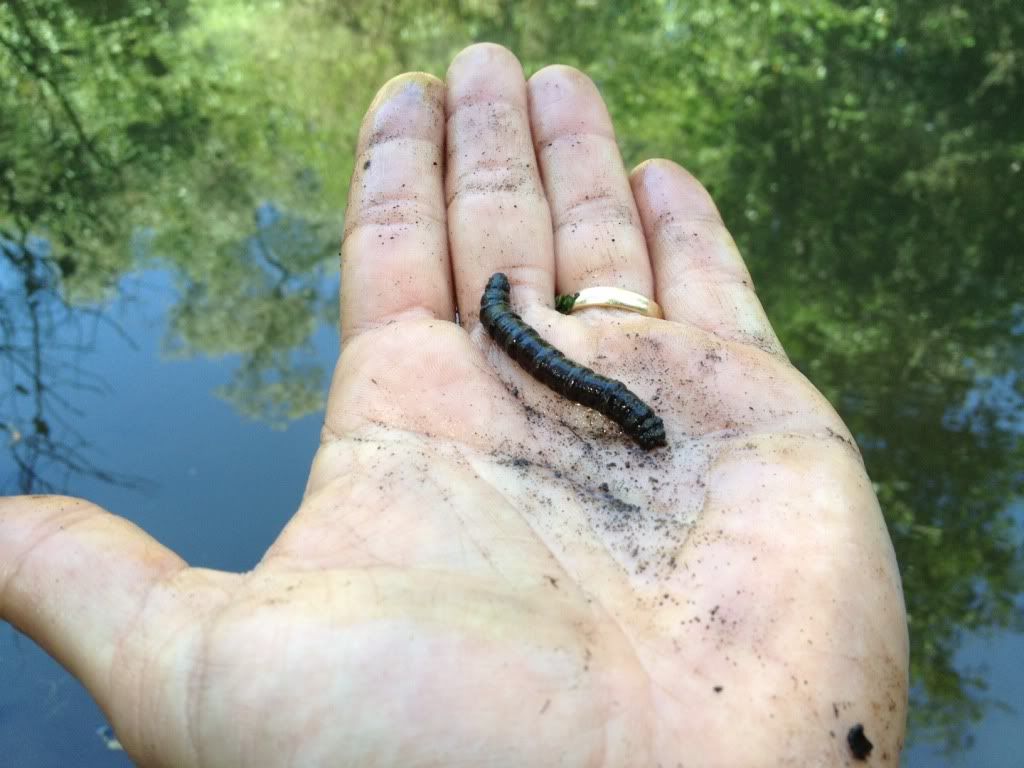
Tks in advance for any orientation,
regards
Ted
One of them had this caterpillar-like bug in its mouth. Can Anyone help with its identification?

Tks in advance for any orientation,
regards
Ted
Starting to fly-fish!
Troutnut on Apr 30, 2012April 30th, 2012, 2:41 pm EDT
It's a cranefly larva, family Tipulidae.
Jason Neuswanger, Ph.D.
Troutnut and salmonid ecologist
Troutnut and salmonid ecologist
TSR on Apr 30, 2012April 30th, 2012, 3:02 pm EDT
That was fast, thank you very much... Now I'll start looking for some crane fly patterns.
Starting to fly-fish!
PaulRoberts on May 1, 2012May 1st, 2012, 8:07 am EDT
Crepuscular on May 1, 2012May 1st, 2012, 5:22 pm EDT
Here's the pattern I used with some success. It's simply made from yarn.
Hey Paul, I like that pattern, the problem with many of the crane fly larva patterns that I have seen are the lack of movement in the water, and if you have ever seen one in the drift, it definitely has movement to it. Looks like you have solved that issue with that fly design.
Eric
PaulRoberts on May 2, 2012May 2nd, 2012, 8:18 am EDT
Hey Eric,
The cranefly pattern I commonly see, is a big straight wad of dubbing -think Walt's Worm. A friend told me how he makes them and they are more than a wad of dubbing, using an underlayment of foam adding buoyancy. He says they don't look like much, and he's right, but they really catch fish. I believe its effectiveness may have as much to do with how well a buoyant wad of dubbing drifts, rather than by mimicry. I put the glo-bug in the same category -sure they mimic eggs in proper context but there seems to be more to it when all colors work, not just egg colors, and at any time.
My yarn cranefly I used only in a certain context: Early spring spate-water that rolled up big food (cranes were part of that there) and big browns were present in that stretch. Not sure how it would do as a "search pattern".
As to movement, even soft acrylic yarn does not move very well supported in water. Sure it'll flex some in turbulence, but it's nothing like marabou -which may be a better idea for anything but really turbulent flow. I would try gold marabou with a contrasting weighted head.
The cranefly pattern I commonly see, is a big straight wad of dubbing -think Walt's Worm. A friend told me how he makes them and they are more than a wad of dubbing, using an underlayment of foam adding buoyancy. He says they don't look like much, and he's right, but they really catch fish. I believe its effectiveness may have as much to do with how well a buoyant wad of dubbing drifts, rather than by mimicry. I put the glo-bug in the same category -sure they mimic eggs in proper context but there seems to be more to it when all colors work, not just egg colors, and at any time.
My yarn cranefly I used only in a certain context: Early spring spate-water that rolled up big food (cranes were part of that there) and big browns were present in that stretch. Not sure how it would do as a "search pattern".
As to movement, even soft acrylic yarn does not move very well supported in water. Sure it'll flex some in turbulence, but it's nothing like marabou -which may be a better idea for anything but really turbulent flow. I would try gold marabou with a contrasting weighted head.
Crepuscular on May 2, 2012May 2nd, 2012, 9:24 am EDT
As to movement, even soft acrylic yarn does not move very well supported in water. Sure it'll flex some in turbulence, but it's nothing like marabou -which may be a better idea for anything but really turbulent flow. I would try gold marabou with a contrasting weighted head.
That's an idea, would you twist up a "rope" of marabu, or just tie it off the bend of the hook like an elongated "tail"?
I have heard alot of people singing the praises of "Walt's worm" can't say that I ever tied one up.
My cranefly larvae pattern is as follows:
Curved shank nymph hook with lead wire wrapped the whole length of the shank, short dun colored marabou clipped short for anal papillae, I then tie in a strip of olive sili skin, I then used grey dubbing over the lead 80 % of the shank then I switch to black or a dark brown for the head portion, then I wrap the sili skin over the dubbing which gives it a translucent olive color with some segmentation.I have to admit I don't use it very often, but I have caught fish on it, in times when the water is up and flowing pretty good. I like it in the fall when the craneflies are in the leaf packs, if we get a substantial push of water which breaks them up.
PaulRoberts on May 2, 2012May 2nd, 2012, 10:39 am EDT
Your pattern sounds good. Your fall leaf pack break-ups sound ideal; Context means a lot.
I haven't made a 'bou cranefly larva. I'd play with making it mostly tail -wolly bugger-like -probably trim the tips so it ends fat rather than too tapered. I'd be playing with fat bou tails (for a "body") in the bathtub. Nothing moves like marabou, although there are some fine synthetics that supposedly move well, and might be translucent. I'd have to pull it out of the package and feel it before I bought any though. Water is thick stuff.
As to twisted bou bodies: I do make nymphs that way. My favorite Isonychia nymph is tied with a twisted (pheasant butt) bou body. Great fly. I could see a fluffy cranefly body done that way, fluffier though. But I'd still play with tails for a body bc cranes can writhe, not just "breath".
Concocting fly patterns is certainly part of the fun.
I haven't made a 'bou cranefly larva. I'd play with making it mostly tail -wolly bugger-like -probably trim the tips so it ends fat rather than too tapered. I'd be playing with fat bou tails (for a "body") in the bathtub. Nothing moves like marabou, although there are some fine synthetics that supposedly move well, and might be translucent. I'd have to pull it out of the package and feel it before I bought any though. Water is thick stuff.
As to twisted bou bodies: I do make nymphs that way. My favorite Isonychia nymph is tied with a twisted (pheasant butt) bou body. Great fly. I could see a fluffy cranefly body done that way, fluffier though. But I'd still play with tails for a body bc cranes can writhe, not just "breath".
Concocting fly patterns is certainly part of the fun.
Crepuscular on May 3, 2012May 3rd, 2012, 4:35 am EDT
PaulRoberts on May 3, 2012May 3rd, 2012, 8:19 am EDT
Very nice. We ff's get to meld art and athletics.
Entoman on May 4, 2012May 4th, 2012, 7:09 am EDT
Eric -
Paul -
Looking for a more durable leech tail, I experimented with craft fur (the long kind). So far, so good. It flows in the water almost like marabou (in size 6 and larger), and as Paul said, it is somewhat translucent and takes marking well without wicking like marabou. As far as twisting, I think you'd end up with what you've already got with Paul's yarn flies (very cool, BTW)... Only after more work and they'd probably be stiffer if twisted tight enough to obtain the same silhouette.
Neither hinged bodies or extended soft ones truly wiggle. But they are flexible and very suggestive of life as they react to current vagaries. Between the two, I generally prefer the soft ones over the hinged as the latter look more stiff in their flexibility and less natural (like a stick on a hinge). As an imitationist, I believe "eyeballs and elbows" can be important, but I also believe if our creations don't do a good job of faking life first, we've wasted our time.
That's an idea, would you twist up a "rope" of marabu, or just tie it off the bend of the hook like an elongated "tail"?
Paul -
Nothing moves like marabou, although there are some fine synthetics that supposedly move well, and might be translucent.
Looking for a more durable leech tail, I experimented with craft fur (the long kind). So far, so good. It flows in the water almost like marabou (in size 6 and larger), and as Paul said, it is somewhat translucent and takes marking well without wicking like marabou. As far as twisting, I think you'd end up with what you've already got with Paul's yarn flies (very cool, BTW)... Only after more work and they'd probably be stiffer if twisted tight enough to obtain the same silhouette.
Neither hinged bodies or extended soft ones truly wiggle. But they are flexible and very suggestive of life as they react to current vagaries. Between the two, I generally prefer the soft ones over the hinged as the latter look more stiff in their flexibility and less natural (like a stick on a hinge). As an imitationist, I believe "eyeballs and elbows" can be important, but I also believe if our creations don't do a good job of faking life first, we've wasted our time.
"It's not that I find fishing so important, it's just that I find all other endeavors of Man equally unimportant... And not nearly as much fun!" Robert Traver, Anatomy of a Fisherman
Entoman on May 7, 2012May 7th, 2012, 10:00 am EDT
Eric & Paul -
I edited the above post to correct the mistake I made crediting the wrong chap with the yarn cranefly larva. Got my posts mixed up. Sorry about that, Paul.:) BTW - That is one grubby looking fly, Eric! Looks realer than real! Kudos.
My apology is a good excuse to post the leech pattern using the craft fur tail I mentioned. I also tie this fly in olive and black versions.
B.H. Polar Leech #6, root beer/burnt orange

I edited the above post to correct the mistake I made crediting the wrong chap with the yarn cranefly larva. Got my posts mixed up. Sorry about that, Paul.:) BTW - That is one grubby looking fly, Eric! Looks realer than real! Kudos.
My apology is a good excuse to post the leech pattern using the craft fur tail I mentioned. I also tie this fly in olive and black versions.
B.H. Polar Leech #6, root beer/burnt orange

"It's not that I find fishing so important, it's just that I find all other endeavors of Man equally unimportant... And not nearly as much fun!" Robert Traver, Anatomy of a Fisherman
Crepuscular on May 8, 2012May 8th, 2012, 4:43 am EDT
Cool fly Kurt, have you ever used any arctic fox tail or Finn raccoon? I have never used temple dog but I heard it has great movement. I'm not sure of how they get it though, do you know anything about that stuff? Arctic fox has some variability as far as suppleness, but most I guess most natural materials seem to have an inherant variability in one form or another. I really like the finn raccon. Those materials are not as translucent as craft fur but for some applications they work really well for me. I tie a variation of Barr's Meat Whistle using either arctic fox tail or Finn Raccoon that is deadly sometimes.
Entoman on May 8, 2012May 8th, 2012, 9:17 am EDT
Eric -
Yes, on steelhead flies. My stock consists of the brighter colors though, so haven't used them for leechy stuff. You're right that it is really cool stuff with similar properties. Expensive though. 20 bucks will get you a lifetime supply of Craft fur in leech colors. Craft fur is great stuff for imitative streamers too. I like to layer different colors with a few strands of flashabou.
have you ever used any arctic fox tail or Finn raccoon?
Yes, on steelhead flies. My stock consists of the brighter colors though, so haven't used them for leechy stuff. You're right that it is really cool stuff with similar properties. Expensive though. 20 bucks will get you a lifetime supply of Craft fur in leech colors. Craft fur is great stuff for imitative streamers too. I like to layer different colors with a few strands of flashabou.
"It's not that I find fishing so important, it's just that I find all other endeavors of Man equally unimportant... And not nearly as much fun!" Robert Traver, Anatomy of a Fisherman
Crepuscular on May 8, 2012May 8th, 2012, 11:08 am EDT
You're right that it is really cool stuff with similar properties. Expensive though. 20 bucks will get you a lifetime supply of Craft fur in leech colors.
Yeah no kidding! I used to be able to get full tails from a guy at the Somerset NJ Fly Fishing Show really cheap, I have tons of it, in different shades of white, tan, cream, brown, and pink. I originally bought it for saltwater stuff like bonefish flies and small deceivers that I use for the small tunas. For blacks and olives I just dyed the lightest ones I had.
Quick Reply
Related Discussions
Topic
Replies
Last Reply
7
May 29, 2012
by Possumpoint
by Possumpoint
12
Apr 12, 2017
by RanchMT
by RanchMT

